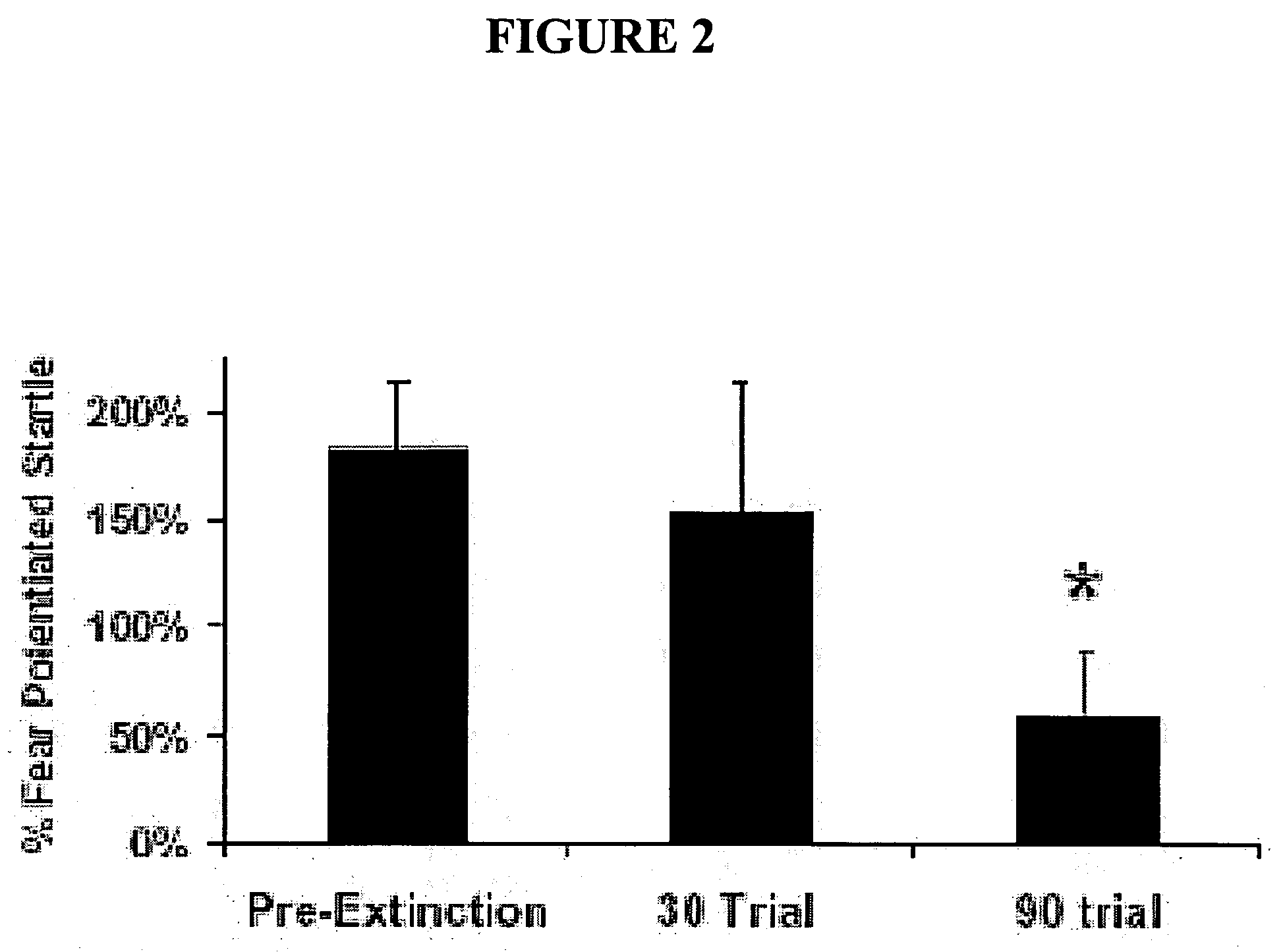Augmentation of psychotherapy with cannabinoid reuptake inhibitors
a cannabinoid reuptake inhibitor and psychotherapy technology, applied in the direction of biocide, heterocyclic compound active ingredients, peptide/protein ingredients, etc., can solve the problem of reducing the ability to extinguish high anxiety response resulting from fear memories, and achieve non-significant reduction of fear, increase cb1 activation, and enhance extinction retention
- Summary
- Abstract
- Description
- Claims
- Application Information
AI Technical Summary
Benefits of technology
Problems solved by technology
Method used
Image
Examples
example 1
In situ Hybridization Study of CB1
[0096] The basolateral amygdala has been repeatedly implicated in the process of extinction of fear with both direct pharmacological inactivation and augmentation studies (Walker et al. (2002) J. Neurosci. 22: 2343-2351; Falls et al. (1992) J. Neurosci. 12(3): 854-863; Davis et al. (2003) Ann. N. Y Acad. Sci. 985, 218-232). In situ hybridization was used to determine if CB1 mRNA was expressed within the rat amygdala and whether it was differentially expressed in the basolateral, medial, and central amygdaloid nuclei. Representative sections from these in situ hybridization studies (FIG. 1), suggest that CB1 mRNA is highly enriched in the BLA, with very little CB1 mRNA expression seen in the central (CeA) or medial nuclei (MeA) of the amygdala. Additionally, the presence of the mRNA for the CB1 protein within the BLA itself suggests that the CB1-mediated signaling taking place in the BLA is part of the intrinsic neurocircuitry of the BLA. These hybr...
example 2
Parametric Evaluation of Different Amounts of Extinction Training
[0097] This experiment assessed the effect on fear-potentiated startle of 30 vs. 90 trials of non-reinforced light-conditioned stimulus (CS) presentations. In these studies, animals showed robust fear conditioning prior to extinction-training and varying the number of non-reinforced light-CS presentations decreased the amount of fear animals showed in subsequent testing trials (FIG. 2). In these studies, 90 trials of non-reinforced lights led to significant extinction retention, whereas only 30 trials led to a non-significant reduction in fear (Compared to pre-extinction: 90 trials, F (1,27)=4.05, p0.05).
example 3
Dose-Response Function for the Effect of a CB1 Receptor Antagonist on Extinction
[0098] This experiment used the 90-trial extinction protocol described in Example 2 to test the ability of systemic administration of the CB1 antagonist rimonabant on extinction in rats. Acute administration of rimonabant to rats immediately prior to extinction training led to a profound disruption of extinction retention, as evidenced by the fact that rimonabant-treated animals showed significantly higher levels of fear in the presence of the light-CS 24 hrs following extinction training (FIG. 3). This disruption in extinction appeared to be dose-dependent, and animals receiving 1.5 mg / kg or 5 mg / kg of rimonabant showed significantly higher levels of conditioned fear than vehicle-treated controls, and appeared to show virtually no reduction in conditioned fear following extinction training (post-hoc, p<0.01 for 1.5 mg / kg and 5 mg / kg compared to vehicle). The ability of rimonabant to disrupt extinction ...
PUM
| Property | Measurement | Unit |
|---|---|---|
| Time | aaaaa | aaaaa |
| Time | aaaaa | aaaaa |
| Time | aaaaa | aaaaa |
Abstract
Description
Claims
Application Information
 Login to View More
Login to View More - R&D
- Intellectual Property
- Life Sciences
- Materials
- Tech Scout
- Unparalleled Data Quality
- Higher Quality Content
- 60% Fewer Hallucinations
Browse by: Latest US Patents, China's latest patents, Technical Efficacy Thesaurus, Application Domain, Technology Topic, Popular Technical Reports.
© 2025 PatSnap. All rights reserved.Legal|Privacy policy|Modern Slavery Act Transparency Statement|Sitemap|About US| Contact US: help@patsnap.com



